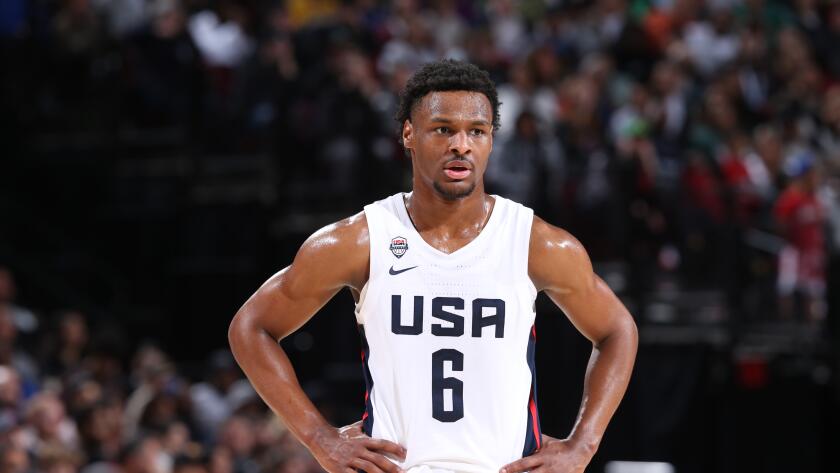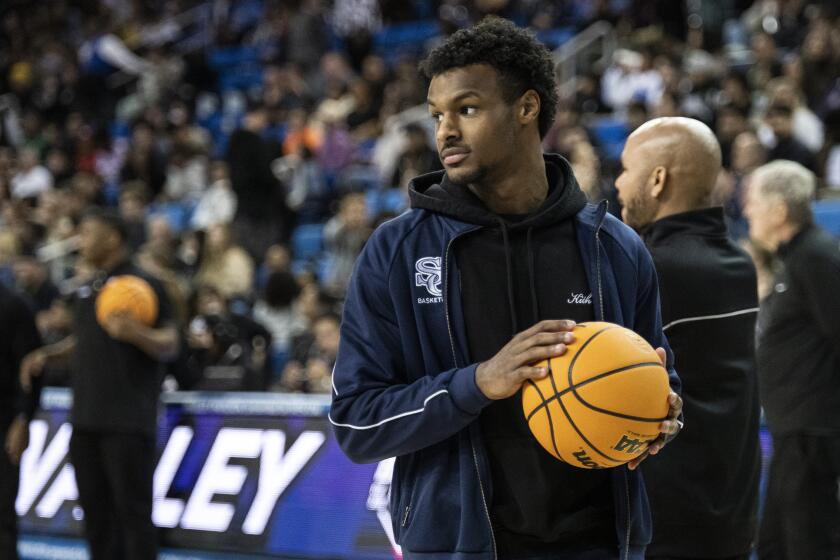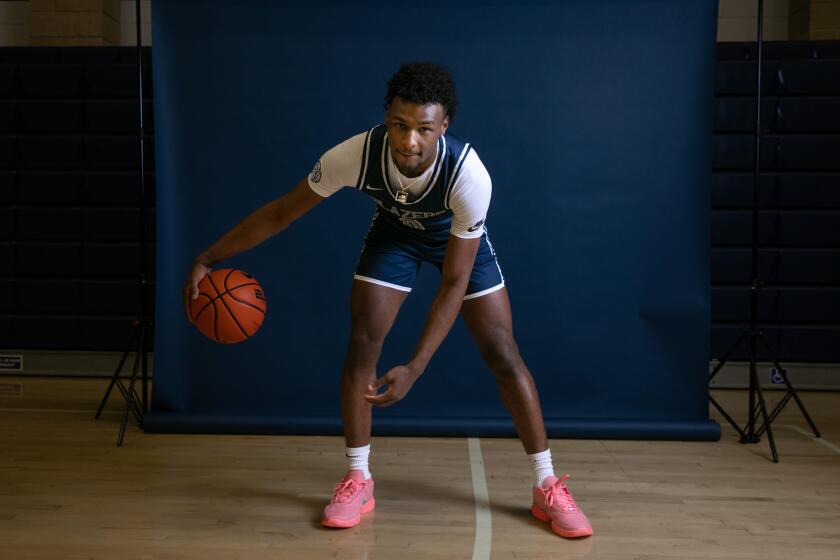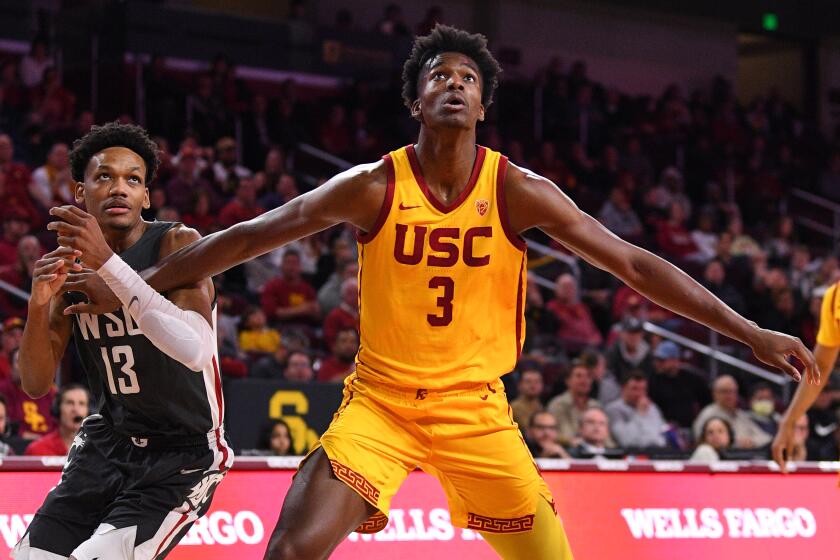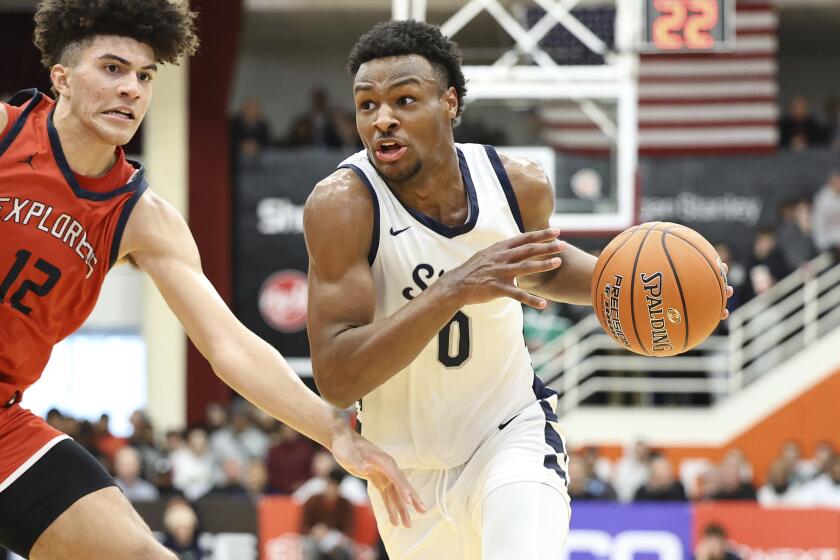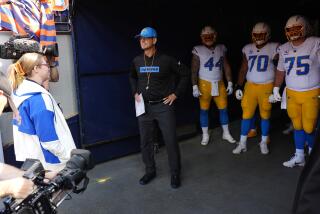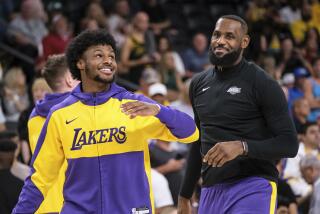Q&A: Why would a young, healthy athlete go into cardiac arrest?
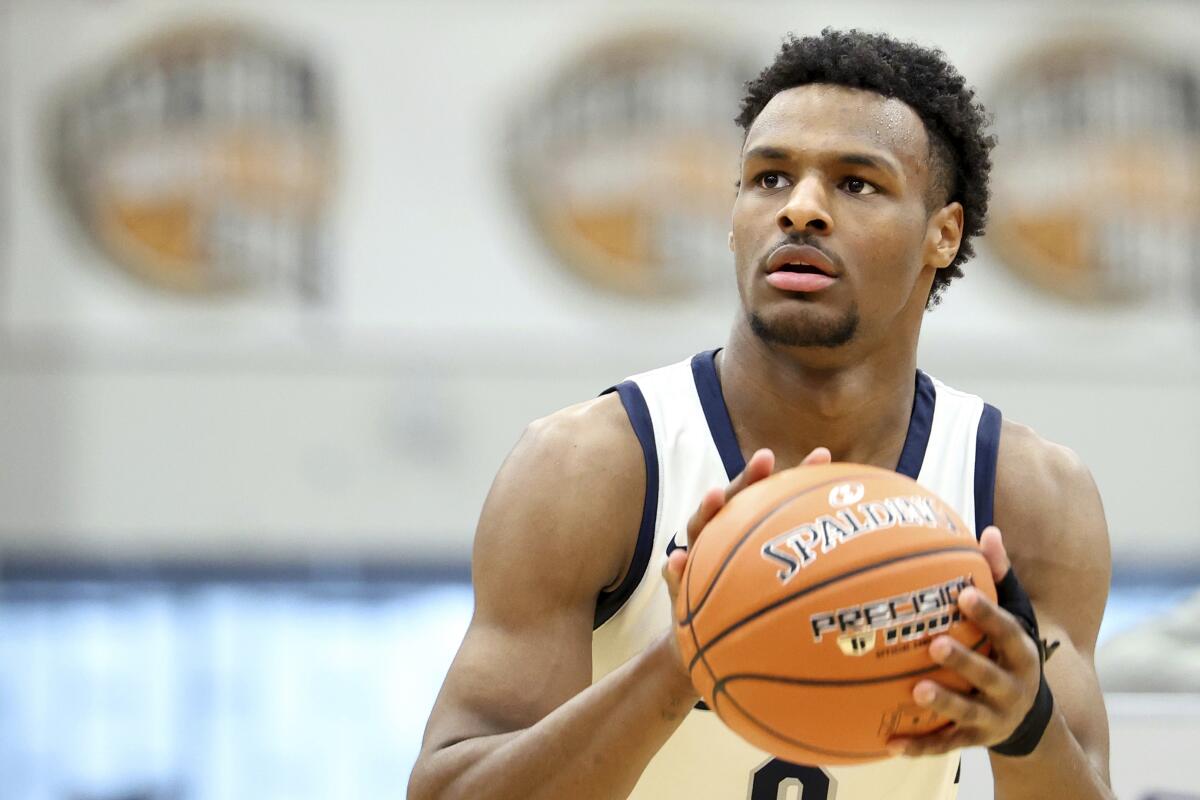
- Share via
The news that USC freshman Bronny James collapsed during basketball practice at the Galen Center on Monday came as a shock.
The son of NBA superstar LeBron James and one of NCAA basketball’s most eagerly watched prospects, 18-year-old James is fit and healthy — and yet still became the most recent high-profile young athlete to suffer cardiac arrest during a game or practice.
In July 2022, James’ future USC teammate Vincent Iwuchukwu went into cardiac arrest and collapsed during practice at the Galen Center at the age of 18. In January, players, spectators and a national television audience watched horrified as 24-year-old Buffalo Bills safety Damar Hamlin suffered cardiac arrest on the field after executing a tackle in a Monday Night Football game.
- Share via
The 18-year-old son of Lakers star LeBron James suffers cardiac arrest during a USC workout Monday. His family says he is in stable condition.
Both Iwuchukwu and Hamlin have made full recoveries and returned to play.
The James family announced Tuesday that Bronny was out of the ICU and in stable condition. The family has not released any additional information about the Trojan’s health; without those details, it’s impossible to know what caused his medical emergency.
For the record:
4:59 p.m. July 25, 2023An earlier version of this story incorrectly said 75% of sports-related deaths are attributable to cardiovascular conditions.
But cardiac catastrophes in otherwise healthy young athletes are not unheard of, said Dr. Satyajit Reddy, a sports cardiologist with the Mayo Clinic in Phoenix. In the U.S., 75% of all sudden deaths that occur while NCAA athletes are playing sports are attributable to cardiovascular conditions, he said.
The 18-year-old son of Lakers star LeBron James suffers cardiac arrest during a USC workout Monday. His family says he is in stable condition.
A 2016 study found that NCAA athletes ran a 1-in-53,703 risk of sudden cardiac death. That burden is not equally shared. If the athlete was Black, their risk more than doubled to 1 in 21,491. And if they were a men’s basketball player, the risk was 1 in 8,978.
When a person is in cardiac arrest, the heart abruptly stops pumping oxygenated blood to the brain and other organs. Without rapid medical attention, it can lead to death in a matter of minutes.
It’s distinct from a heart attack, which occurs when clogged arteries aren’t able to deliver blood to the heart muscle, causing it to die. Heart attacks are often preceded by symptoms like chest pain and shortness of breath, which can serve as emergency signals to seek immediate treatment.
While many players do make full recoveries after cardiac arrest, for others, the consequences can be tragic. The Times spoke with Reddy about the factors that cause cardiac emergencies in athletes, and what contributes to survival.
Why do we see cardiac arrests in seemingly healthy young athletes?
There are a number of reasons. When people are being physically active and exercising, they put their body under a lot of stress. Things like electrolyte abnormalities or the blood pressure and heart rate changes that come with exercise can exacerbate an underlying condition that would otherwise go unnoticed.
A number of different conditions can lead to cardiac arrest: arrhythmic causes [relating to an irregular heartbeat], arterial causes [when the arteries can’t provide enough blood to the heart], heart muscle causes. It’s unclear what happened in this particular case.
Bronny James, a USC basketball freshman and son of LeBron James, suffered a cardiac arrest at practice. Magic Johnson and others offer their support.
Are heart attacks in young athletes on the rise?
To be honest, I’m not 100% sure, but I know it’s now gaining a lot more media coverage. From a medical standpoint, it’s good to have these events be broadcast so that people understand how to respond in the future and get education for these things.
Why are basketball players at greater risk of cardiovascular crises than other athletes?
It’s hard to say for certain, but one possibility is that basketball demands a lot of high-intensity bursts of activity. That places increased stress on the heart compared to a sport like soccer, where an athlete is running longer distances at a somewhat lower intensity.
An inside look at Bronny James’ unique senior season, during which he was helped and hindered by his famous father LeBron James.
Why are Black athletes more likely to suffer cardiac events?
The highest risk of heart events are in athletes of Afro-Caribbean descent. A lot of these athletes come from poor socioeconomic backgrounds. They may have an underlying condition that a general provider could have picked up on, but they may not have had access to those providers growing up.
Even if a Black athlete has access to healthcare, does bias — unconscious or not — play a role in the quality of care they receive?
Certainly, that’s possible. There’s not a lot of overlap between the ethnic background of most physicians and the ethnic background of athletes. [In the NCAA, 45% of Division I football players and 52% of men’s basketball players are Black, compared with less than 3% of U.S. cardiologists.]
Can anything increase the chance of survival in such incidents?
A favorable result is most likely when you have people at the site who are trained in CPR, people that know what to do when there is an emergency like this, so that they’re not scrambling. There’s an emergency action plan already in place. The athletic trainers, the coaches, even other teammates or bystanders — they know what to do in these situations.
How did USC and Vincent Iwuchukwu find a way to get the game-changing player back on the court after he suffered cardiac arrest during preseason practice?
The likelihood of someone surviving cardiac arrest is directly related to how quickly you can start CPR, the quality of the CPR, and how soon you can use something called an automated external defibrillator, or AED. Every sports facility should have an AED close by and available. A lot of times people will have a fallen athlete and they’ll be scrambling to find the defibrillator. Sometimes it’s locked upstairs in the office.
Having access to an AED and having people who know how to use the device — those are the most important things with these arrest episodes.
What is recovery like for survivors?
It depends on the underlying cause of the cardiac arrest. If it is something that was reversible, or that can be prevented with medications and other therapies, then certainly they can continue to play their sport.
That being said, there are some conditions where we say that despite all treatments, competitive sports may not be the best thing. Ultimately it comes down to a discussion with the athlete about whether they want to take on that risk.
LeBron James thanked USC staff for treating Bronny James when he suffered cardiac arrest, but LAUSD athletes are unlikely to get comparable aid.
Damar Hamlin has said that his heart attack was caused by commotio cordis. What is that?
That’s a very specific cause of cardiac arrest that occurs when there is blunt force trauma to the heart, or the chest wall that overlies the heart. That mechanical force against the heart can disrupt the rhythm of the heart and cause an arrhythmia to occur. It’s very rare.
Some on social media have speculated that these events are linked to the COVID vaccine. Can you comment on that?
I don’t think there’s any evidence for that. The vaccine is associated with a slight increase in myocarditis, which is inflammation of the heart muscle, especially in men under 30. But if you get COVID-19, the risk of having sudden cardiac arrest due to myocarditis is a magnitude higher than the risk that comes potentially with taking the vaccine. If you’re looking at it from that perspective, it’s a no-brainer to take the vaccine.
This conversation has been lightly edited for length and clarity.
